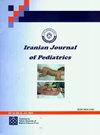不同胎盘输注策略及其对足月婴儿短期血液学参数的影响
IF 0.4
4区 医学
Q4 PEDIATRICS
引用次数: 0
摘要
背景:推迟脐带夹紧可产生更令人满意的神经学和血液学结果。延迟脐带夹紧的另一种替代方法是脐带挤奶。目的:本研究旨在评估不同胎盘输注技术对足月新生儿血液学参数的影响。方法:本观察性研究包括120名足月婴儿,分为延迟夹脐带60秒(DCC)组、以10厘米/秒的速度剪断脐带4次(CCM)组、完整脐带4次(ICM)组和立即夹脐带(ICC)的历史对照组。这项研究的主要结果是出生时和24小时的血液学参数。高胆红素血症、红细胞增多症或呼吸窘迫是次要结局。结果:新生儿中位胎龄39(37 ~ 40)周,出生体重3270(2365 ~ 4850)克。ICM组脐带血红蛋白(Hb)和红细胞压积(Hct)水平显著高于对照组(P < 0.01)。DCC组、CCM组和ICM组24 h血红蛋白和Hct水平基本相同,且显著高于ICC组(P < 0.01)。各组间在高胆红素血症、红细胞增多症和呼吸窘迫方面无显著差异。结论:据我们所知,本研究是评估不同胎盘输注策略对足月婴儿血液学参数影响的最全面的研究之一,也是首次探索足月婴儿脐带完整挤奶的研究。完整脐带挤奶被认为与出生时较高的血红蛋白水平有关。在早期血液学参数方面,所有DCC、ICM和CCM技术都比ICC更有效。本文章由计算机程序翻译,如有差异,请以英文原文为准。
Different Placental Transfusion Strategies and Their Effects on Short - Term Hematological Parameters in Term Infants
Background: Deferring the umbilical cord clamping produces more satisfactory neurological and hematological outcomes. Another alternative for the deferred umbilical cord clamping is the umbilical cord milking. Objectives: This study aimed to evaluate different placental transfusion techniques in terms of hematological parameters for term neonates. Methods: This observational study included 120 term infants assigned to groups of deferred cord clamping for 60 seconds (DCC), cut cord milking for four times with a speed of 10 cm/second (CCM), intact cord milking for four times (ICM), and a historical control group of immediate cord clamping (ICC). The primary outcome of this study was hematological parameters at birth and 24th hours. Hyperbilirubinemia, polycythemia, or respiratory distress were secondary outcomes. Results: The median gestational ages and birth weights of neonates were 39 (37 - 40) weeks and 3270 (2365 - 4850) grams, respectively. Umbilical cord hemoglobin (Hb) and hematocrit (Hct) levels were significantly higher in the ICM group (P < 0.01). Hemoglobin and Hct levels at 24th hours of life were similar in DCC, CCM, and ICM groups and significantly higher than those in the ICC group (P < 0.01). No significant difference was found among the groups in terms of hyperbilirubinemia, polycythemia, and respiratory distress. Conclusions: To the best of our knowledge, this study was one of the most comprehensive studies evaluating the effects of different placental transfusion strategies on hematological parameters in term infants and the first study exploring intact cord milking in term infants. Intact cord milking was suggested to be associated with higher hemoglobin levels at birth. All DCC, ICM, and CCM techniques were found to be more effective than ICC in terms of early hematological parameters.
求助全文
通过发布文献求助,成功后即可免费获取论文全文。
去求助
来源期刊
CiteScore
0.90
自引率
20.00%
发文量
75
审稿时长
6-12 weeks
期刊介绍:
Iranian Journal of Pediatrics (Iran J Pediatr) is a peer-reviewed medical publication. The purpose of Iran J Pediatr is to increase knowledge, stimulate research in all fields of Pediatrics, and promote better management of pediatric patients. To achieve the goals, the journal publishes basic, biomedical, and clinical investigations on prevalent diseases relevant to pediatrics. The acceptance criteria for all papers are the quality and originality of the research and their significance to our readership. Except where otherwise stated, manuscripts are peer-reviewed by minimum three anonymous reviewers. The Editorial Board reserves the right to refuse any material for publication and advises that authors should retain copies of submitted manuscripts and correspondence as the material cannot be returned. Final acceptance or rejection rests with the Editors.

 求助内容:
求助内容: 应助结果提醒方式:
应助结果提醒方式:


